Giant-Size Man-Thing
Nathaniel Sandler
—Steve Gerber, Adventure into Fear #19 (December 1973)
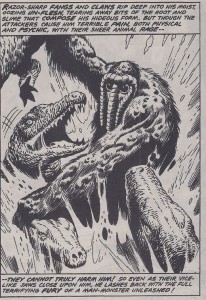
1. FALLING THROUGH TIME AND SPACE may sound terrifying, but for space demons and interplanetary warlords, it’s really just an end to a means. Earth appears a pretty easy place to conquer if you’ve got super-villain powers and certainly worth the sniff of a forked-tongue-fire-breathing-winged-devil. Us God-fearing earthlings would like to think the proper authorities are monitoring all cross-dimensional wormholes, but the government is mostly unaware of one right in our own backyard. The Nexus of All Realities is located in the Florida Everglades and as the name suggests, it’s a portal to every single current or possible reality. Basically down the street, this discomforting gateway to the infinite existences of a vast multiverse hovers over the wilting sawgrass, a few angry gators, and even fewer confused swamp rats. It’s one of those thresholds you probably don’t want to pass through, not to mention greet any visitors from the other side.
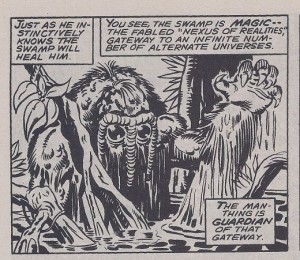
2. A FICTIONAL DEUS EX MACHINA, the Nexus of All Realities from the Marvel Comics continuity is guarded by a soggy swamp monster known as the Man-Thing. Countless absurd things come through the Nexus in the creature’s chronicles— most famously the alien Howard the Duck (of the later, notorious 1986 washout film). The Nexus is primarily used as a plot device for bizarre netherworld beasts and incongruous deep-space enemies, who all somehow plopped themselves in the boggy waters of the Everglades. Accidentally opened by a member of a cult that worships a prophetess who foretold the demise of Atlantis, the Nexus is also an attractive force for the behavior of peculiar humans.
Man-Thing is a muck monster and effectively unkillable, due to his body composition of sticks and slime alongside his ability to reform itself after maiming. He was once a military scientist named Ted Sallis who lived in the swamp with his wife Ellen Brandt, working on recreating the super soldier serum that enhanced Captain America. In Sallis’s origin story, terrorists try to steal the formula, Ellen betrays him, and during a desperate getaway, his car plunges into a marsh as he stabs himself with the serum. He rises from the abysmal sludge changed, a Man-Thing unable to speak and barely sentient. Empathy is the creature’s only form of communication. Wandering the swamp, defending good from evil while understanding nothing but the emotions of other beings: love, hate, rage, and, most importantly, fear. Lovecraft would have been proud.
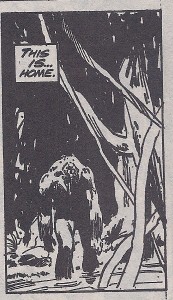
3. THE MOTIF OF THE SWAMP MONSTER isn’t a hugely new concept and wasn’t in the 1970s, either, when the great Stan Lee and Roy Thomas created him. Two months after Man-Thing’s first appearance (Adventure into Fear #10, October 1972), the more famously named Swamp Thing of Detective Comics hit newsstands (House of Secrets #92, July 1971). Strangely, the writers who launched the two characters—Gerry Conway (MT) and Len Wein (ST)—were roommates at the time. It’s hard to imagine two roommate comic book writers not spit-balling over their respective and basically identical projects, but neither publisher decided on legal action, most likely due to similarities to another character named the Heap from the 1940s. Copyrighting, litigating, or claiming ownership of the concept of a swamp monster is for some reason not feasible—nebulous like the beasts themselves.
Virtually unknown outside of the sphere of hardcore comic book nerds, Man-Thing is one of the more eccentric and thought-provoking stories of South Florida ever created. Though the miry character has had a few iterations since its first appearance, the iconic original series ran in color from January 1974 to October 1975 and was written entirely by Gerber, a relatively unknown scribe who took to comics because he hated the drudgery of advertising. For thirty-nine issues, Gerber crafted one of the most legendary runs of comic book writing you’ll ever encounter. Through the muck and the hardwood, his macabre Man-Thing fought demons and real estate developers, but never once speaks, severely limiting a medium based half on words.
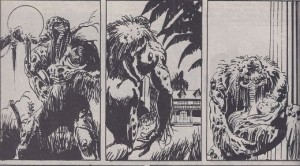
4. BUT HE IS GOOD. It is good. He saves an abandoned baby, a wayward radio DJ, damsels in distress, and numerous people the reader identifies as good. Probably a testament to the era’s attitude toward reptiles, Man-Thing also seems to really hate alligators and sometimes flings about snakes. Archetypes of evil physically burn at the touch of his branch-like appendages. Sensing fear, he scalds the skin of his frightened enemies for “whatever knows fear burns at the Man-Thing’s touch,” an oft-repeated line. Lumbering constantly—wet and fighting emotional onslaught—Man-Thing battles demons as well as evil men. For several issues, the main antagonist is a man named F. A. Schist, who is dead-set on draining the swamp to build an airport. Developers, even in fantasy, remain a looming threat to the imagined purity of South Florida. Another fantasy is that Schist does not succeed.
Red-eyed and endlessly weary, Man-Thing actually looks like Cthulhu the Lovecraftian sea monster and deity that inflicts untold mental horrors onto those who behold it. Mentally, the former sentience of Sallis burgeons through recognizing objects or feelings that are human, but the slime-crawler’s sanity is all but erased and memory is an endless blur. Chaos, struggle, and the unknown are constant, much like the landscape of the Everglades itself. Man-Thing embodies the terrain emotionally, a literal and figurative sponge and, like the swamp, his story can only be told by the constantly rotating cast of people who interact with it.
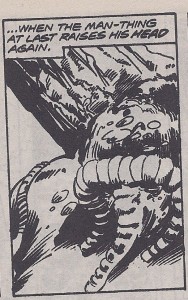
5. ABSURDITY IS WELCOME in this environment, but also understood when your comic book title is a childish synonym for a penis. Lee came up with the name and had to have known. Apparently, double meanings were not lost on either the fans or the creators, since there were five issues of Giant-Size Man-Thing (“Giant-Size” being an occasional bonus feature indicating more pages). The humor doesn’t stop there; the beast falls trying to take the stairs and in one issue he’s caught and placed in a museum, where he awkwardly bumps into the walls, confused. And damn it, he’s actually kind of cute.
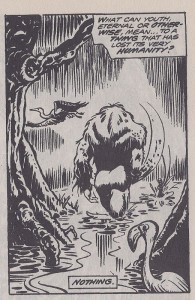
6. ALL OF THIS IS GERBER’S WAY of reminding us through the lens of a swamp monster that human existence is absurd and deeply existential. His message seems progressive in nature, particularly with his portrayals of strong female characters, and in giving a voice (albeit, somewhat crudely) to the Native Americans in their fight with the developer Schist. Gerber, who died in 2008, actually writes himself into the final issue of his own run of Man-Thing (#22), claiming all of it was true and he was merely recounting the stories told to him by a wizard who crossed through the Nexus of All Realities. We suspend belief yet again, only to purposefully wonder at the unanswered questions that Man-Thing cannot ask and cannot mindfully choose to help or destroy. The battle against demons is not in our control. Reality vulnerably bends while fate is cruelly left to a mindless pile of mud and branches.
We must find solace in the fact that he is good. It is good.
Nathaniel Sandler is a writer and the founding director of Bookleggers Library and will gladly spend any amount of time talking about swamp monsters with you.









